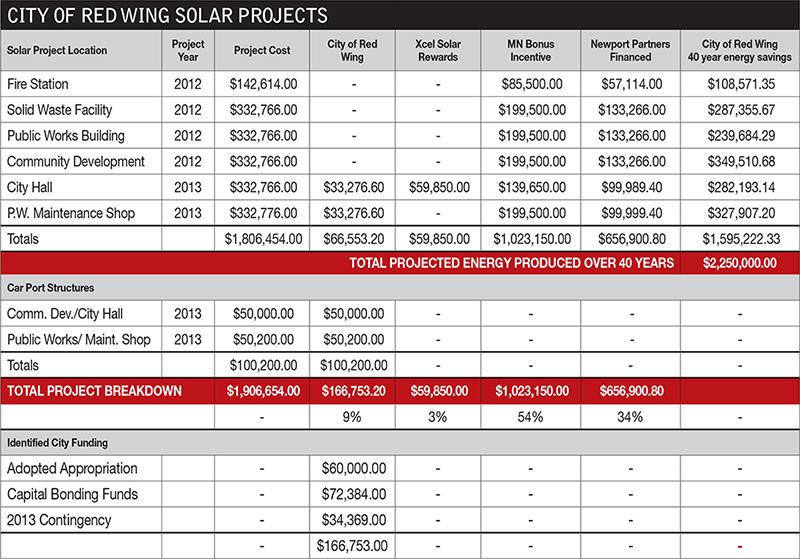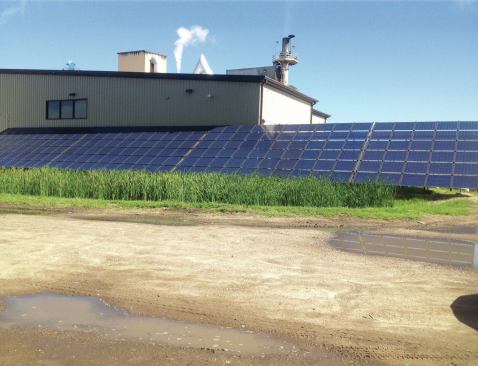All Energy Solar
To transition to a hybrid alternative-energy system, power to th…
Identifying sites, funding sources
We began by identifying five appropriate sites for rooftop solar installations. In addition to the public works administration building, they were the fire station, public works maintenance shop, solid waste facility, and community development building. With All Energy Solar’s help, we submitted applications for 2012 grant, incentive, and financing programs that would fund 100% of four.
Funding for all but one of the four, the public works maintenance shop, was approved.
We began structural engineering design and plan development. The process revealed that the community development building roof couldn’t support the additional weight of solar panels and other necessary equipment. In October 2012, the city council approved the financial agreements and construction at all four sites, provided we found an alternative mounting system for the community development building.
All Energy Solar and public works discussed a ground-mount solar energy system and installing a carport system over part of the parking lot. We eventually realized that a carport system over the entire parking lot would generate enough power to also supply city hall—a location we’d considered but rejected because the building is on the National Register of Historic Places. Solar panels would significantly alter its appearance.
That led us to think about what we had planned for the other two sites.
The public works administration building and solid waste facility had been approved for roof-mounted systems capable of withstanding wind gusts of 105 mph (the required standard). That summer, though, a rooftop system elsewhere in Minnesota was damaged by 120 mph winds. Given the extreme weather patterns of the last several years, we decided on a carport system for public works and a ground-mounted system for the solid waste facility.
Having successfully established a financing process, we decided to apply for two more installations: the public works maintenance shop (not approved in 2012) and city hall. This year, however, the city had to be willing to pay 10% of costs. The 90/10 split would demonstrate the applicant’s commitment to investing in solar energy and enable more projects to be built.
The financing contracts used the same language that was approved in 2012, and all contracts were reviewed by the city attorney’s office before acceptance. The Sustainability Commission supported all of the installations because they contribute to the city’s strategic plan for reducing overall energy consumption.
Our applications were approved. Since city hall is next to the community development building, a carport structure was installed there. Ditto the public works administration building and maintenance shop.
Come see for yourself
According to the agreements with Newport Partners, the city will incur no maintenance costs for the first six and one-half years. We’ll take over routine maintenance in year seven, when the city takes ownership of the installations. At that point, public works will continue to spray the solar panels twice every year with water to remove dust and dirt and be responsible for all repairs and maintenance for the solar electrical systems. Being the first to try a project like this was scary. But now that we’re on the back side of the process, we want to show others how to make this work. From the very beginning, we’ve wanted Red Wing to be an educational site.
This is exciting stuff, the best project I’ve worked on in 32 years at the city. The technology is getting better and the price is coming down. These systems will pay for themselves over the long term.
Public works: innovation partner
In August, Minnesota Gov. Mark Dayton attended an open house at the City of Red Wing’s Community Development Building showcasing the city’s efforts over the last two years to use renewable forms of energy. One of his first questions about the building’s new carport solar-electric system was whether the photovoltaic panels were made in the state.
City council president Lisa Bayley happily told him the equipment was made four hours north in Mountain Iron, Minn., by Silicon Energy.
Though a relatively small community of roughly 17,000 residents, the open house marked two innovations:
- The building was one of six throughout the city that are the fruits of the state’s first public-private partnership for solar energy.
- It’s also home to Red Wing Ignite, an incubator site for developing and deploying high-speed broadband technology. U.S. Ignite was launched in June 2012 because of an executive order issued by President Obama requiring federal agencies to develop consistent processes to facilitate broadband deployment. Red Wing is the smallest of 25 cities designated as a technology base for new business under the program.







